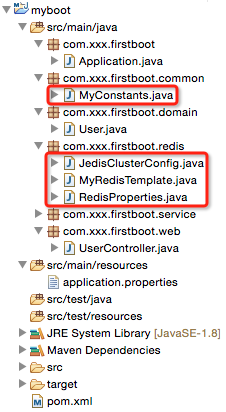第三章 引入jedisCluster,第三章jediscluster
如果使用的是redis2.x,在項目中使用客戶端分片(Shard)機制。(具體使用方式:第九章 企業項目開發--分布式緩存Redis(1) 第十章 企業項目開發--分布式緩存Redis(2))
如果使用的是redis3.x中的集群,在項目中使用jedisCluster。
1、項目結構

2、pom.xml

![]()
1 <?xml version="1.0" encoding="UTF-8"?>
2 <project xmlns="http://maven.apache.org/POM/4.0.0" xmlns:xsi="http://www.w3.org/2001/XMLSchema-instance"
3 xsi:schemaLocation="http://maven.apache.org/POM/4.0.0 http://maven.apache.org/maven-v4_0_0.xsd">
4
5 <modelVersion>4.0.0</modelVersion>
6
7 <groupId>com.xxx</groupId>
8 <artifactId>myboot</artifactId>
9 <version>1.0-SNAPSHOT</version>
10
11 <properties>
12 <java.version>1.8</java.version><!-- 官方推薦 -->
13 </properties>
14 <!-- 引入spring-boot-starter-parent做parent是最好的方式,
15 但是有時我們可能要引入我們自己的parent,此時解決方式有兩種:
16 1)我們自己的parent的pom.xml的parent設為spring-boot-starter-parent(沒有做過驗證,但是感覺可行)
17 2)使用springboot文檔中的方式:見spring-boot-1.2.5-reference.pdf的第13頁
18 -->
19 <parent>
20 <groupId>org.springframework.boot</groupId>
21 <artifactId>spring-boot-starter-parent</artifactId>
22 <version>1.2.5.RELEASE</version>
23 </parent>
24
25 <!-- <dependencyManagement>
26 <dependencies>
27 <dependency>
28 Import dependency management from Spring Boot
29 <groupId>org.springframework.boot</groupId>
30 <artifactId>spring-boot-dependencies</artifactId>
31 <version>1.2.5.RELEASE</version>
32 <type>pom</type>
33 <scope>import</scope>
34 </dependency>
35 </dependencies>
36 </dependencyManagement> -->
37
38 <!-- 引入實際依賴 -->
39 <dependencies>
40 <dependency>
41 <groupId>org.springframework.boot</groupId>
42 <artifactId>spring-boot-starter-web</artifactId>
43 </dependency>
44 <dependency>
45 <groupId>redis.clients</groupId>
46 <artifactId>jedis</artifactId>
47 </dependency>
48 <dependency>
49 <groupId>com.alibaba</groupId>
50 <artifactId>fastjson</artifactId>
51 <version>1.1.15</version>
52 </dependency>
53 <dependency>
54 <groupId>org.apache.commons</groupId>
55 <artifactId>commons-lang3</artifactId>
56 <version>3.3.2</version>
57 </dependency>
58 </dependencies>
59
60 <build>
61 <plugins>
62 <!-- 用於將應用打成可直接運行的jar(該jar就是用於生產環境中的jar) 值得注意的是,如果沒有引用spring-boot-starter-parent做parent,
63 且采用了上述的第二種方式,這裡也要做出相應的改動 -->
64 <plugin>
65 <groupId>org.springframework.boot</groupId>
66 <artifactId>spring-boot-maven-plugin</artifactId>
67 </plugin>
68 </plugins>
69 </build>
70 </project>
View Code
說明:相對於上一章的代碼僅僅引入了jedis的依賴jar。
3、application.properties

![]()
1 #user info
2 user.id=1
3 user.username=zhaojigang
4 user.password=123
5
6 #redis cluster
7 redis.cache.clusterNodes=localhost:8080
8 redis.cache.commandTimeout=5
9 #unit:second
10 redis.cache.expireSeconds=120
View Code
說明:相對於上一章的代碼僅僅引入了redis cluster的配置信息
4、Application.java(springboot啟動類,與上一章一樣)
5、RedisProperties.java(Redis屬性裝配)

![]()
1 package com.xxx.firstboot.redis;
2
3 import org.springframework.boot.context.properties.ConfigurationProperties;
4 import org.springframework.stereotype.Component;
5
6 @Component
7 @ConfigurationProperties(prefix = "redis.cache")
8 public class RedisProperties {
9
10 private int expireSeconds;
11 private String clusterNodes;
12 private int commandTimeout;
13
14 public int getExpireSeconds() {
15 return expireSeconds;
16 }
17
18 public void setExpireSeconds(int expireSeconds) {
19 this.expireSeconds = expireSeconds;
20 }
21
22 public String getClusterNodes() {
23 return clusterNodes;
24 }
25
26 public void setClusterNodes(String clusterNodes) {
27 this.clusterNodes = clusterNodes;
28 }
29
30 public int getCommandTimeout() {
31 return commandTimeout;
32 }
33
34 public void setCommandTimeout(int commandTimeout) {
35 this.commandTimeout = commandTimeout;
36 }
37
38 }
View Code
說明:與上一章的User類似,采用@ConfigurationProperties注解自動讀取application.properties文件的內容並裝配到RedisProperties的每一個屬性中去。
6、JedisClusterConfig.java(獲取JedisCluster單例)

![]()
1 package com.xxx.firstboot.redis;
2
3 import java.util.HashSet;
4 import java.util.Set;
5
6 import org.springframework.beans.factory.annotation.Autowired;
7 import org.springframework.context.annotation.Bean;
8 import org.springframework.context.annotation.Configuration;
9
10 import redis.clients.jedis.HostAndPort;
11 import redis.clients.jedis.JedisCluster;
12
13 @Configuration
14 public class JedisClusterConfig {
15
16 @Autowired
17 private RedisProperties redisProperties;
18
19 /**
20 * 注意:
21 * 這裡返回的JedisCluster是單例的,並且可以直接注入到其他類中去使用
22 * @return
23 */
24 @Bean
25 public JedisCluster getJedisCluster() {
26 String[] serverArray = redisProperties.getClusterNodes().split(",");//獲取服務器數組(這裡要相信自己的輸入,所以沒有考慮空指針問題)
27 Set<HostAndPort> nodes = new HashSet<>();
28
29 for (String ipPort : serverArray) {
30 String[] ipPortPair = ipPort.split(":");
31 nodes.add(new HostAndPort(ipPortPair[0].trim(), Integer.valueOf(ipPortPair[1].trim())));
32 }
33
34 return new JedisCluster(nodes, redisProperties.getCommandTimeout());
35 }
36
37 }
View Code
說明:
- 該類注入了RedisProperties類,可以直接讀取其屬性
- 這裡沒有對jedis鏈接池提供更多的配置,具體的配置屬性可以查看文章開頭第一篇博客
注意:
- 該類使用了Java注解,@Configuration與@Bean,
- 在方法上使用@Bean注解可以讓方法的返回值為單例,
- 該方法的返回值可以直接注入到其他類中去使用
- @Bean注解是方法級別的
- 如果使用的是常用的spring注解@Component,
- 在方法上沒有注解的話,方法的返回值就會是一個多例,
- 該方法的返回值不可以直接注入到其他類去使用
- 該方式的注解是類級別的
7、MyRedisTemplate.java(具體redis操作)

![]()
1 package com.xxx.firstboot.redis;
2
3 import org.slf4j.Logger;
4 import org.slf4j.LoggerFactory;
5 import org.springframework.beans.factory.annotation.Autowired;
6 import org.springframework.stereotype.Component;
7
8 import redis.clients.jedis.JedisCluster;
9
10 @Component
11 public class MyRedisTemplate {
12 private static final Logger LOGGER = LoggerFactory.getLogger(MyRedisTemplate.class);
13
14 @Autowired
15 private JedisCluster jedisCluster;
16
17 @Autowired
18 private RedisProperties redisProperties;
19
20 private static final String KEY_SPLIT = ":"; //用於隔開緩存前綴與緩存鍵值
21
22 /**
23 * 設置緩存
24 * @param prefix 緩存前綴(用於區分緩存,防止緩存鍵值重復)
25 * @param key 緩存key
26 * @param value 緩存value
27 */
28 public void set(String prefix, String key, String value) {
29 jedisCluster.set(prefix + KEY_SPLIT + key, value);
30 LOGGER.debug("RedisUtil:set cache key={},value={}", prefix + KEY_SPLIT + key, value);
31 }
32
33 /**
34 * 設置緩存,並且自己指定過期時間
35 * @param prefix
36 * @param key
37 * @param value
38 * @param expireTime 過期時間
39 */
40 public void setWithExpireTime(String prefix, String key, String value, int expireTime) {
41 jedisCluster.setex(prefix + KEY_SPLIT + key, expireTime, value);
42 LOGGER.debug("RedisUtil:setWithExpireTime cache key={},value={},expireTime={}", prefix + KEY_SPLIT + key, value,
43 expireTime);
44 }
45
46 /**
47 * 設置緩存,並且由配置文件指定過期時間
48 * @param prefix
49 * @param key
50 * @param value
51 */
52 public void setWithExpireTime(String prefix, String key, String value) {
53 int EXPIRE_SECONDS = redisProperties.getExpireSeconds();
54 jedisCluster.setex(prefix + KEY_SPLIT + key, EXPIRE_SECONDS, value);
55 LOGGER.debug("RedisUtil:setWithExpireTime cache key={},value={},expireTime={}", prefix + KEY_SPLIT + key, value,
56 EXPIRE_SECONDS);
57 }
58
59 /**
60 * 獲取指定key的緩存
61 * @param prefix
62 * @param key
63 */
64 public String get(String prefix, String key) {
65 String value = jedisCluster.get(prefix + KEY_SPLIT + key);
66 LOGGER.debug("RedisUtil:get cache key={},value={}", prefix + KEY_SPLIT + key, value);
67 return value;
68 }
69
70 /**
71 * 刪除指定key的緩存
72 * @param prefix
73 * @param key
74 */
75 public void deleteWithPrefix(String prefix, String key) {
76 jedisCluster.del(prefix + KEY_SPLIT + key);
77 LOGGER.debug("RedisUtil:delete cache key={}", prefix + KEY_SPLIT + key);
78 }
79
80 public void delete(String key) {
81 jedisCluster.del(key);
82 LOGGER.debug("RedisUtil:delete cache key={}", key);
83 }
84
85 }
View Code
注意:
這裡只是使用了jedisCluster做了一些字符串的操作,對於list/set/sorted set/hash的操作,可以參考開頭的兩篇博客。
8、MyConstants.java(緩存前綴常量定義類)

![]()
1 package com.xxx.firstboot.common;
2
3 /**
4 * 定義一些常量
5 */
6 public class MyConstants {
7 public static final String USER_FORWARD_CACHE_PREFIX = "myboot:user";// user緩存前綴
8 }
View Code
注意:
- 根據業務特點定義redis的緩存前綴,有助於防止緩存重復導致的緩存覆蓋問題
- 緩存前綴使用":"做分隔符,這是推薦做法(這個做法可以在使用redis-desktop-manager的過程看出來)
9、UserController.java(測試)

![]()
1 package com.xxx.firstboot.web;
2
3 import org.apache.commons.lang3.StringUtils;
4 import org.springframework.beans.factory.annotation.Autowired;
5 import org.springframework.web.bind.annotation.RequestMapping;
6 import org.springframework.web.bind.annotation.RequestParam;
7 import org.springframework.web.bind.annotation.RestController;
8
9 import com.alibaba.fastjson.JSON;
10 import com.xxx.firstboot.common.MyConstants;
11 import com.xxx.firstboot.domain.User;
12 import com.xxx.firstboot.redis.MyRedisTemplate;
13 import com.xxx.firstboot.service.UserService;
14
15 /**
16 * @RestController:spring mvc的注解,
17 * 相當於@Controller與@ResponseBody的合體,可以直接返回json
18 */
19 @RestController
20 @RequestMapping("/user")
21 public class UserController {
22
23 @Autowired
24 private UserService userService;
25
26 @Autowired
27 private MyRedisTemplate myRedisTemplate;
28
29 @RequestMapping("/getUser")
30 public User getUser() {
31 return userService.getUser();
32 }
33
34 @RequestMapping("/testJedisCluster")
35 public User testJedisCluster(@RequestParam("username") String username){
36 String value = myRedisTemplate.get(MyConstants.USER_FORWARD_CACHE_PREFIX, username);
37 if(StringUtils.isBlank(value)){
38 myRedisTemplate.set(MyConstants.USER_FORWARD_CACHE_PREFIX, username, JSON.toJSONString(getUser()));
39 return null;
40 }
41 return JSON.parseObject(value, User.class);
42 }
43
44 }
View Code
說明:相對於上一章,只是添加了測試緩存的方法testJedisCluster。
測試:
在Application.properties右擊-->run as-->java application,在浏覽器輸入"localhost:8080/user/testJedisCluster?username=xxx"即可。
附:對於redis的測試,我們有時需要查看執行set後,緩存是否存入redis的db中了,有兩種方式
- 執行set後,get數據,之後修改數據,在get數據,比較兩次get的數據是否相同即可
- 有時,這些數據是無法修改的(假設該數據是我們從第三方接口得來的),這個時候可以使用redis-desktop-manager這個軟件來查看緩存是否存入redis(該軟件的使用比較簡單,查看官網)







